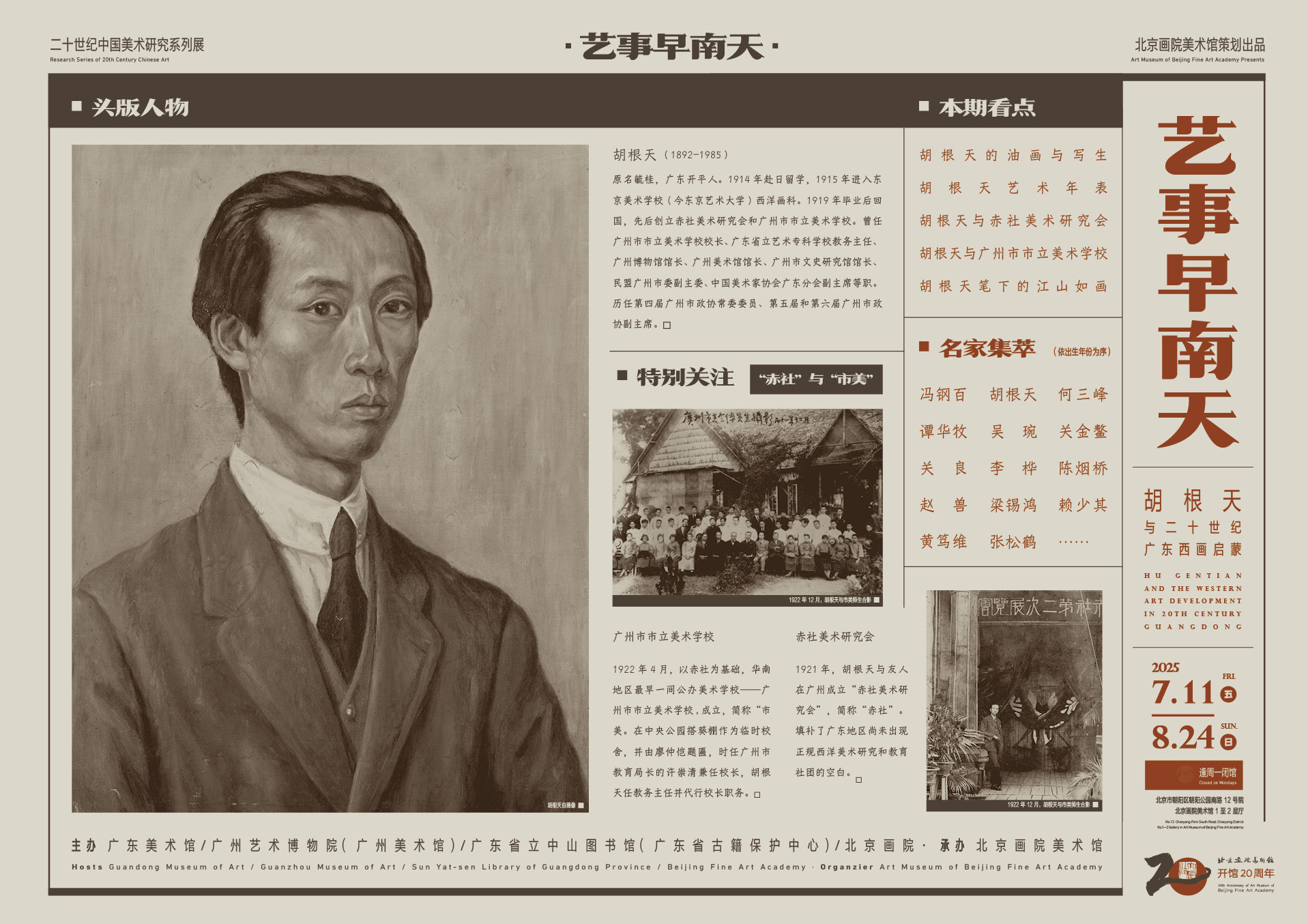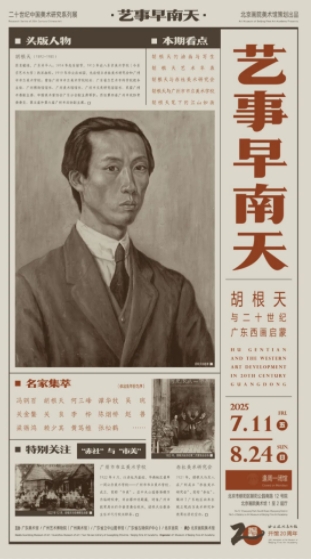Artistic Dawn in Lingnan—Hu Gentian and the Western Art Development in 20th Century Guangdong

- show time:2025-07-11 to 2025-08-24
- Organizer:Guangdong Museum of Art, Guangzhou Museum of Art, Sun Yat-sen Library of Guangdong Province (Ancient Books Protection Center of Guangdong Province), Beijing Fine Art Academy
- venue:Beijing Academy of Fine Arts
On July 11, the “Artistic Dawn in Lingnan—Hu Gentian and the Western Art Development in 20th Century Guangdong”, jointly held by Guangdong Museum of Art, Guangzhou Museum of Art, Sun Yat-sen Library of Guangdong Province (Ancient Books Protection Center of Guangdong Province) and Beijing Fine Art Academy, was open at the exhibition halls in the 1st and 2nd floors of the Art Museum of Beijing Fine Art Academy.
In support of the exhibition, the Art News Express is especially issued with limited copies, which will be distributed free of charge at the exhibition from July 11 to August 24. First come, first served.

Art News Express front page & exhibition poster
Front page figure: Hu Gentian
The front page of this issue highlights Hu Gentian, an artist from Guangdong Province. On the Teacher’s Day in 1992, Mr. Guan Shanyue wrote a poem commemorating his mentor Hu Gentian:
Leading the early development of Western art in Lingnan,
Chishe Art Research Society pioneered its introduction.
In commemoration of my mentor’s centennial birth,
I will remember his visionary guidance for ever.
Wu Hongliang, president of Beijing Fine Art Academy, wrote in the exhibition foreword: “Looking back on Mr. Hu Gentian’s artistic journey is like retrieving a silent artistic code amid the noise.” Hu, a great master of Lingnan culture whose brilliance was briefly obscured by the dust of history, returned to his homeland during the turbulent years in the early 20th century, bringing back Western literary and educational concepts acquired in Japan. Since then, he had devoted himself to establishing new cultural orders and transforming the modern Chinese art.
.png)
Self-portrait, Hu Gentian, 61 x 45.5 cm, Oil on Canvas
1919, Collection of the University Art Museum, Tokyo University of the Arts
Hu was born in 1892 to an ordinary overseas Chinese family in Kaiping County in Guangdong Province. His mother died of illness in 1914. At 22, supported by his emigrant laborer father, Hu departed for Tokyo School of Fine Arts to study Western painting.
When graduating in 1919, he brought home modern art education philosophies and humanist ideals. Founding the Chishe Art Research Society and Guangzhou Municipal Fine Arts School, he enlightened public understanding and aesthetic taste of Western art while establishing Guangdong’s earliest higher art education system.
Hu’s later years witnessed his enduring contributions to Guangdong’s cultural heritage development—from museums, art galleries, and historical archives to art academies, cultural federations, and artists’ associations. As a pivotal founder of Guangdong’s modern art education and cultural preservation and museums in the 20th century, his legacy extends beyond artistic creation to the cultural “ecosystem” he meticulously cultivated throughout his life.
.png)
A Sleeping Cat, Hu Gentian, 20.5 x 26.5 cm, Pencil on paper
1930s, Private collection
.png)
Sanjiang Scenery Series 3, Hu Gentian, 20 x 28 cm
Ink and wash on paper with bamboo brush, 1939, Private collection
Special feature: Chishe and Guangzhou Municipal Fine Arts School
In 1921, Hu Gentian established Chishe Art Research Society (Chishe) with his friends in Guangzhou, filling the blankness in Guangdong’s artistic landscape—the absence of a formal Western art research and education organization. This pioneering initiative provided a dynamic platform for artistic exchange and intellectual discourse.
From October 1 to 7 of the same year, the First Western Painting Exhibition of Chishe was held in the auditorium and playground of Guangzhou Municipal Normal School, showcasing more than 160 works—including oil paintings, watercolors, pastels, charcoal sketches, and pencil drawings by artists such as Hu Gentian, Chen Qiushan, Liang Luan, Xu Shouyi, Mei Yutian, and Lei Yuxiang. This event marked Guangdong’s first-ever Western art exhibition.
In the following years, Chishe’s annual exhibitions attracted an increasing number of returned artists, including Feng Gangbai, Zhao Yating, Huang Chaokuan, Guan Liang, Guan Jin’ao and Li Tiefu, who joined the society and collectively advanced the creation and dissemination of Western art in China.
“The enlightenment of Western art gradually ushered in a new era, overturning the outdated practice of mere imitation and plagiarism in artistic circles.”
——Hu Gentian
.png)
In 1922, the second art exhibition of Chishe was held in a shanty erected on the northeast corner of Guangzhou Central Park. Chishe members in the first row from left: Mei Yutian (Yutian), Hu Gentian; the second row from left: Liang Luan, Lu Zishu, Chen Qiushan, Feng Gangbai, Xu Shouyi (Dongbai)
.png)
Landscape, Hu Gentian, 28 x 38 cm, Oil on paper
1950s, Private collection
.png)
Female Head, Feng Gangbai, 61 x 51.5 cm, Oil on canvas
Collection of Guangdong Museum of Art
.png)
Drama Character Series 2, Guan Liang 34.5x35cm, Ink and color on paper
1953, Collection of Beijing Fine Art Academy
.png)
German Royal Palace, Guan Jin’ao, 78.5 x 61 cm, Oil on canvas
1938, Collection of Guangzhou Museum of Art
In April 1922, based on Chishe, Guangzhou Municipal Fine Arts School was established as the first public fine arts school in South China with temporary thatched-roof classrooms erected in Guangzhou Central Park (now People’s Park). The school’s name plaque was inscribed by Liao Zhongkai, while Xu Chongqing—then director of Guangzhou’s Education Bureau—served as its nominal president, and Hu Gentian acted as both academic dean and de facto administrator.
.png)
In December 1922, Hu Gentian (eighth from left in the first row) took a group photo with teachers and students of Guangzhou Municipal Fine Arts School.
.png)
A panoramic picture of the school buildings of Guangzhou Municipal Fine Arts School in Guangzhou Central Park taken in 1926
Though initially offering only Western painting programs, Guangzhou Municipal Fine Arts School established an early higher art teaching system by referencing the modern art pedagogy of Japan, transitioning from the traditional master-apprentice training system to modern institutional instruction. In addition, the school also introduced interdisciplinary courses such as Chinese literature, foreign languages, art history, aesthetics, anatomy, color theory, and perspective studies, and published school journals such as Fine Arts and Students of Guangzhou Municipal Fine Arts School, pioneering modern art education in Guangdong.
.png)
Fine Arts Issue 5, published in 1936 by the Guangzhou Municipal Fine Arts School, housed in Sun Yat-sen Library of Guangdong Province.
The school recruited renowned returned artists such as Feng Gangbai, Tan Huamu, He Sanfeng, Xu Dungu, Guan Liang, Ni Yide and Chen Zhifo, who introduced diverse Western modern art knowledge and concepts, while mentoring emerging talents like Li Hua, Wu Wan, Zhao Shou, Liang Xihong, Chen Yanqiao, Lai Shaoqi, Zhang Songhe, and Huang Duwei.
This exhibition will showcase a collection of works from these famous artists, many of which are exhibited in Beijing for the first time. It’s a golden opportunity and a must-see exhibition.
.png)
Returning Cattle, Tan Huamu, 39 x 48 cm, Oil on canvas
Collection of Guangdong Museum of Art
.png)
Looking West from Water Tower at Guanyin Mountain, He Sanfeng, 63 x 91 cm, Oil on canvas
1948, Collection of Guangzhou Museum of Art
.png)
Bitter Smile, Li Hua, 23 x15.5 cm, Color woodcut
1940, Collection of Guangdong Museum of Art
.png)
Orchid, Zhao Shou, 26.5 x 33 cm, Watercolor on paper
1976, Collection of Guangdong Museum of Art
.png)
Flowers, Liang Xihong, 42 x 34 cm, Oil on canvas
1931, Collection of Guangdong Museum of Art
.png)
Window, Chen Yanqiao, 21.5 x 15.5 cm, Black and white woodcut
1933, Collection of Guangdong Museum of Art
.png)
Harbor Lights, Lai Shaoqi, 44.5 x 62.5 cm, Color print
1974, Collection of Guangdong Museum of Art
.png)
The Battle Journey Has Its End, Zhang Songhe, 98 x 79 cm, Color woodcut
Collection of Beijing Fine Art Academy
.png)
Snow Scene, Huang Duwei, 23 x 31 cm, Watercolor on paper
1943, Collection of Guangdong Museum of Art
In addition, the exhibition also features several precious manuscripts. “Recalling My Mother” traces Hu Gentian’s upbringing as the youngest son in an overseas laborer family, where he and his mother survived by relying solely on each other. The “Record of Cultivation in the Art Garden” is firsthand narratives of Hu’s artistic life, detailing his art studies in Japan.
What is even more special is a letter written by Ye Gongchuo, the first president of the Beijing Fine Art Academy, to Hu Gentian. As shown in the letter, the two Guangdong scholars’ systematic thinking on cultural construction carries the initial connection between Beijing Fine Art Academy and Hu Gentian, as well as the Lingnan area.
.png)
The letter written by Ye Gongchuo, first president of Beijing Fine Art Academy, to Hu Gentian.
Private collection
Welcome to the Art Museum of Beijing Fine Art Academy between July 11 and August 24 to discover the pivotal role of Hu Gentian and his contemporaries in shaping the Western art enlightenment movement in Guangdong in the 20th century.
This exhibition is not just an ordinary solo exhibition of the artist presenting his personal achievements, but an observation of a galaxy of artists who were active in the Lingnan area at the beginning of the 20th century: Feng Gangbai, Guan Liang, Guan Jin’ao, Tan Huamu, He Sanfeng, Wu Wan, Li Hua, Zhao Shou, Liang Xihong, Chen Yanqiao, Zhang Songhe, Lai Shaoqi, Huang Duwei, among others.
In the tumultuous first half of the 20th century, they responded to contemporary realities through artistic expression, propelling social advancement with innovative art tides. Their pioneering efforts and steadfast dedication continue to guide us today, offering insights to address lingering cultural challenges.
Hu Gentian (1892-1985)
Originally named Yugui, born in Kaiping, Guangdong Province.
In 1914, he embarked on his studies in Japan and in 1915, he enrolled in the Western Painting Department of Tokyo School of Fine Arts (today’s Tokyo University of the Arts).
After graduating in 1919, he returned to China and successively founded the Chishe Art Research Society and the Guangzhou Municipal Fine Arts School.
He served as the principal of Guangzhou Municipal Fine Arts School, academic director of Guangdong Provincial Art College, curator of Guangzhou Museum, curator of Guangzhou Art Museum, director of Guangzhou Institute of Culture and History, vice chairman of the Guangzhou Municipal Committee of the China Democratic League, and vice chairman of the Guangdong Branch of the China Artists Association
He had also served as a member of the Standing Committee of the Fourth Guangzhou Municipal Committee of the Chinese People’s Political Consultative Conference (CPPCC) and vice chairman of the Fifth and Sixth Guangzhou Municipal Committee of the CPPCC.
.jpg)
.jpg)
.jpg)
.jpg)
.jpg)
.jpg)
.jpg)
.jpg)
.jpg)
.jpg)
.jpg)
.jpg)
.jpg)
.jpg)
.jpg)
.jpg)
.png)
.png)
.png)
.png)
.png)
.png)
.png)
.png)
.png)
.png)
.png)
.png)
.png)
.png)
.png)
.png)
.png)
.png)
.png)
.png)
.png)
.png)
.png)